World Championships – 2024
Circolo vela Torbole
August 2-9, 2024
 Photo Credit: Gleb Turchinovich Gleb.Turchinovich@gmail.com
Photo Credit: Gleb Turchinovich Gleb.Turchinovich@gmail.com
The 2024 International 14 World Championships were held on Lake Garda in Torbole Italy. Torbole is next door to the better known Riva Del Garda. Both clubs sail on the same water which is on most all sailors bucket list of locations to sail, certainly in the skiff sailing crowd. Seventy boats from six different countries were present. The always strong GBR (18) and AUS (14) teams were both well represented. The up and coming GER (20) team have the biggest, and youngest, fleet in the world and are very inspiring to meet and see how they are getting young recently graduated university sailors involved by purchasing second and third hand boats from the UK fleet and having wild social events which stimulates even more interest in the younger sailors who are looking for challenging and fun sailing. The lone ITA (1) boat is usually sailed in the UK and has an Italian female crew. The CAN (5) team has 3 recently built Ovington Bieker 6 boats which have been living in the UK doing European events over this past year, an additional 2 boats were Ro-Ro’d from Halifax. The USA (11) sent 8 boats in a 40’ container from the west coast. Two additional USA boats have been staying in GER and being sailed in European events. An additional new Ovington built B6 was delivered to Torbole for this event and is making the return trip in the US container. There were 7 female helms, and 6 female crew.
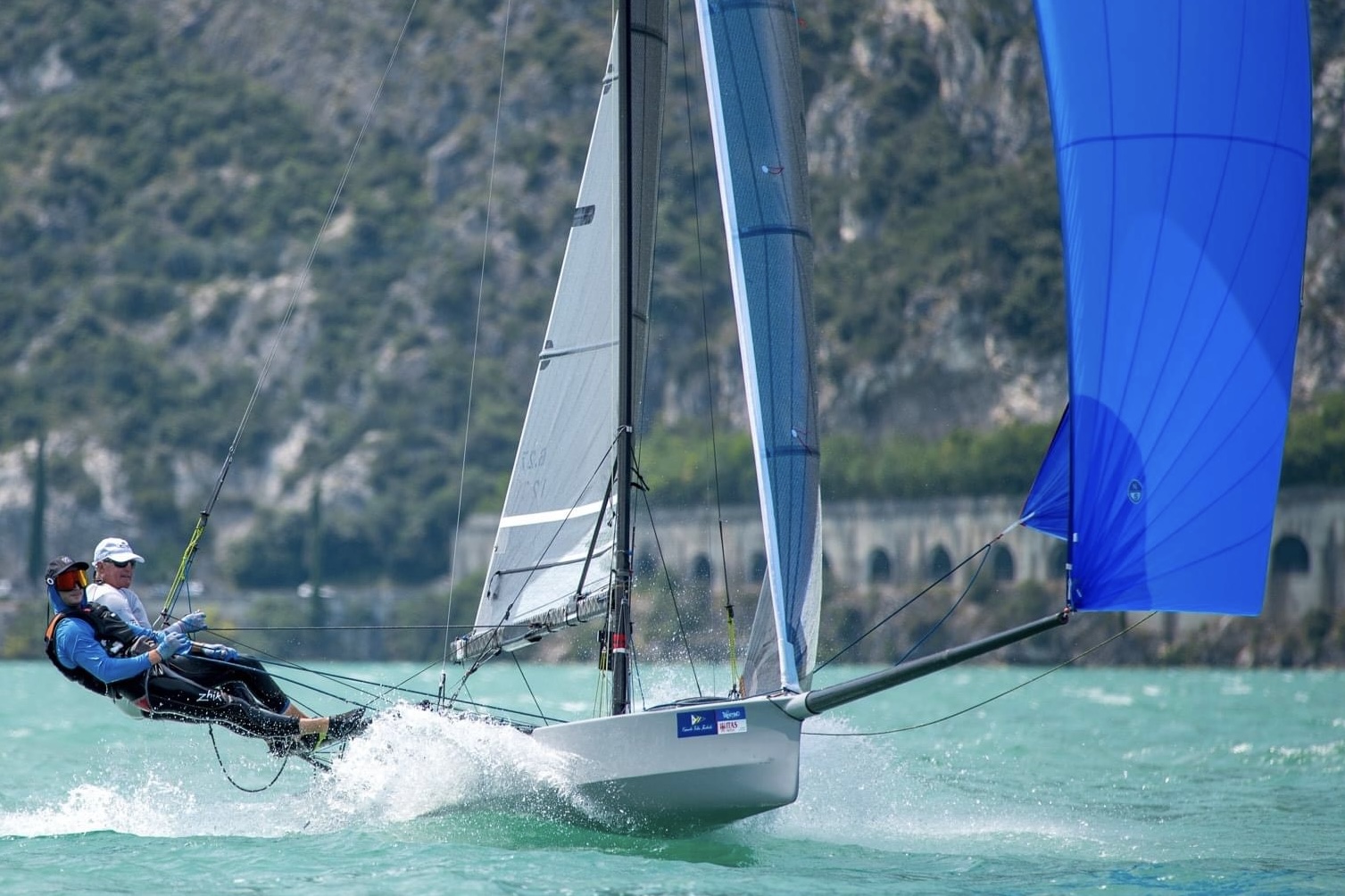 Photo Credit: Gleb Turchinovich Gleb.Turchinovich@gmail.com
Photo Credit: Gleb Turchinovich Gleb.Turchinovich@gmail.com
Lake Garda is a very unique place to sail. The typical day starts with an early morning northerly breeze, the “Pella”, which is a draining breeze from the surrounding mountains. The Italian Dolomites are just north of the area. This allows early morning kite, wing and sailboarding sessions which can have hundreds of boards on the water between 0600-1000. This breeze gradually decreases usually around 1000 and the thermals start to kick in. Almost like clock work, between 1000-1200 the southerly “Ora” starts to build which by 1300 is often 10-15 and continues to build to 15-20 with occasional 20+ puffs. There are occasional afternoon thunderstorms which can bring in some serious weather. Reminded me of growing up sailing on the Great Lakes. We experienced one during the later race days where several boats were flattened by the 30-40 kt. puffs and needed to stay over through the squalls with thunder, lightning and hail. All boats were either retrieved by RIBs and volunteer sailors or self rescued after the 30-45 min. storm front.
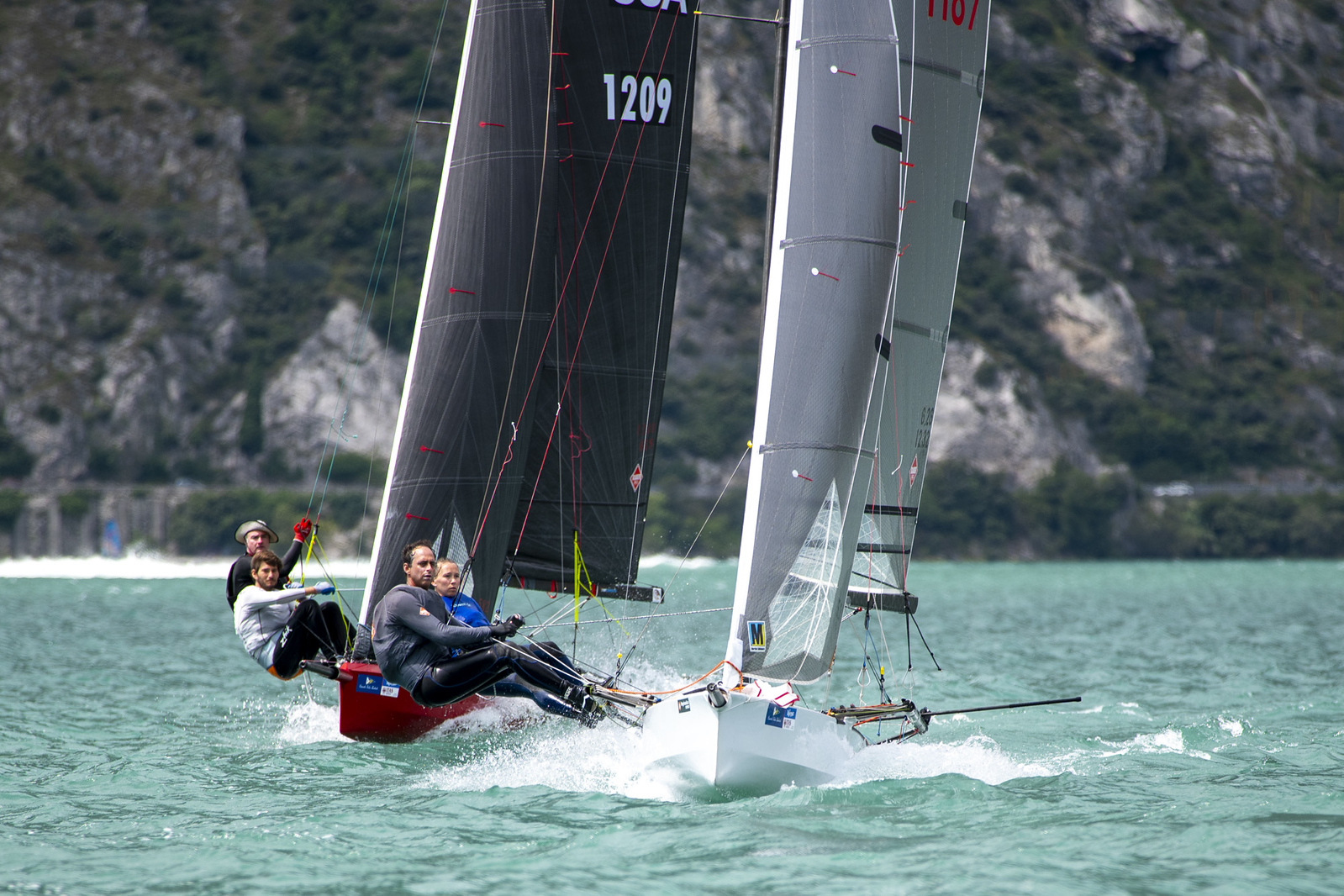 Photo Credit: Gleb Turchinovich Gleb.Turchinovich@gmail.com
Photo Credit: Gleb Turchinovich Gleb.Turchinovich@gmail.com
The racing started with the traditional Team Racing Championships which has been an important as well as fun event during the 14 Worlds. The Team racing was The World Championship up until 1979 when the first Individual World Champions were crowned. International 14 team racing is 4 on 4 team racing on a digital ’N’ course. All the same team racing rules apply with different combinations due to being 4×4, this makes for interesting racing with Kites being used on these high speed skiffs. Quick decisions have to be made and boat handling is at a premium. Unfortunately, the USA did not field a team for the team racing event this year. The GBR team defeated the AUS team after two long days of racing. That leads to one of the most anticipated evenings of the whole World Championship event, “The Team Racing Party”. Each country involved presents a skit, and the stories that come from this evening are legendary! I’ll leave those stories for the bar.
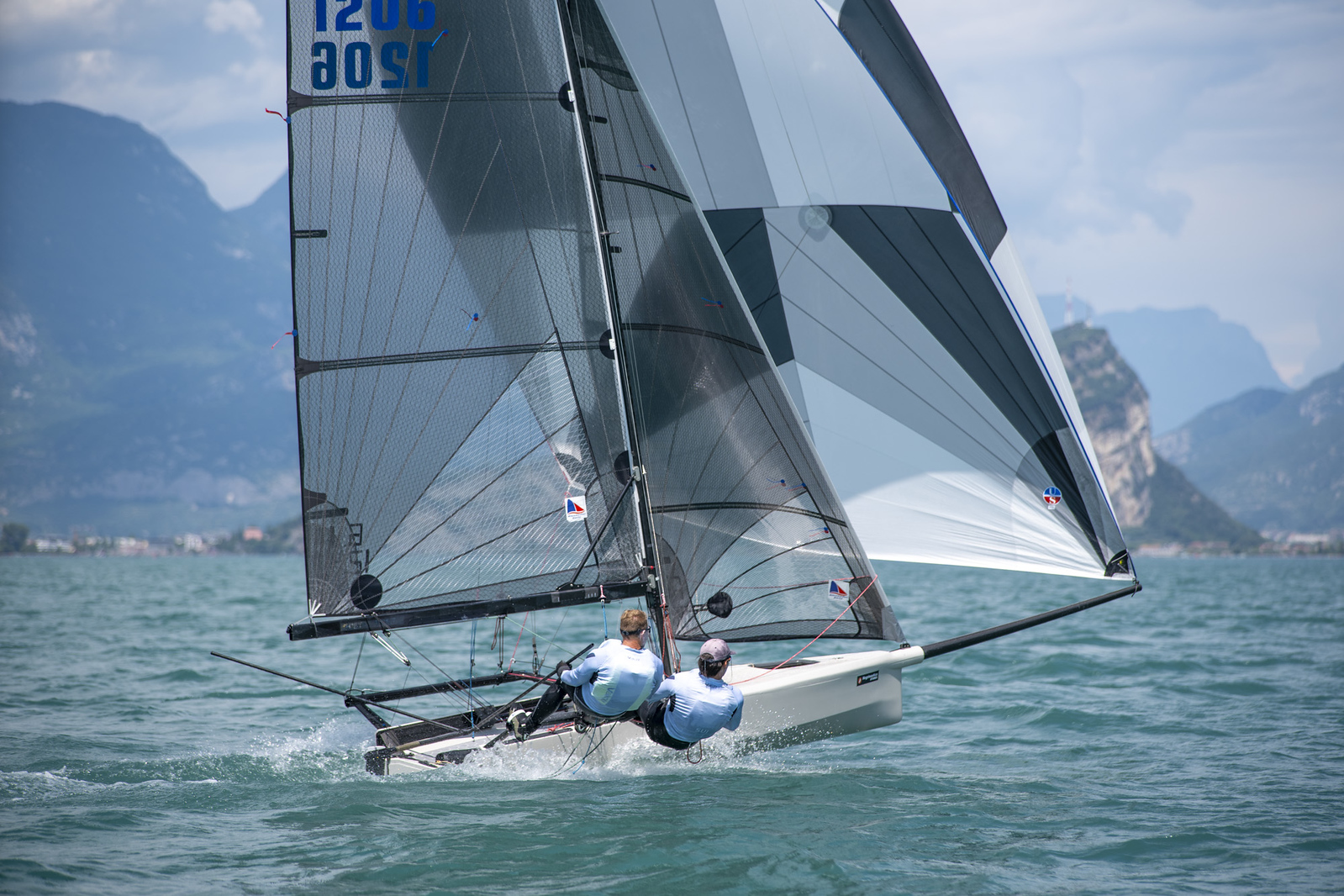 Photo Credit: Gleb Turchinovich Gleb.Turchinovich@gmail.com
Photo Credit: Gleb Turchinovich Gleb.Turchinovich@gmail.com
The following day was the I-14 Lake Garda Traditional “Bastardo Cup” race. This event has taken place historically at all Lake Garda prior 14 events and the course is usually announced at the “Ora Bar” at midnight the night prior to the race by the prior winner. He makes up the rules and course with the “winner” getting rewarded the ‘Bastardo Cup” which is a bronze boot which when turned upside down is filled with a liter of Grappa and the winner and crew must drink the Grappa, or find additional willing participants. There is also a $500 euro penalty if they do not show up for the next event to defend their cup. This year’s course involved having the boat on it’s side with mast in the water behind the starting line when the start gun goes off. Sailing across Lake Garda to a sailing club a few miles up the lake. Adjacent to the club there are “some swimming bouys along the edge” which the crew must touch and then sail back to the finish. Needless to say, it is / was a fun race and thankfully we started early so were determined to be OCS and our finishing first was not counted “Thankfully”. Avoided that Grappa at least!
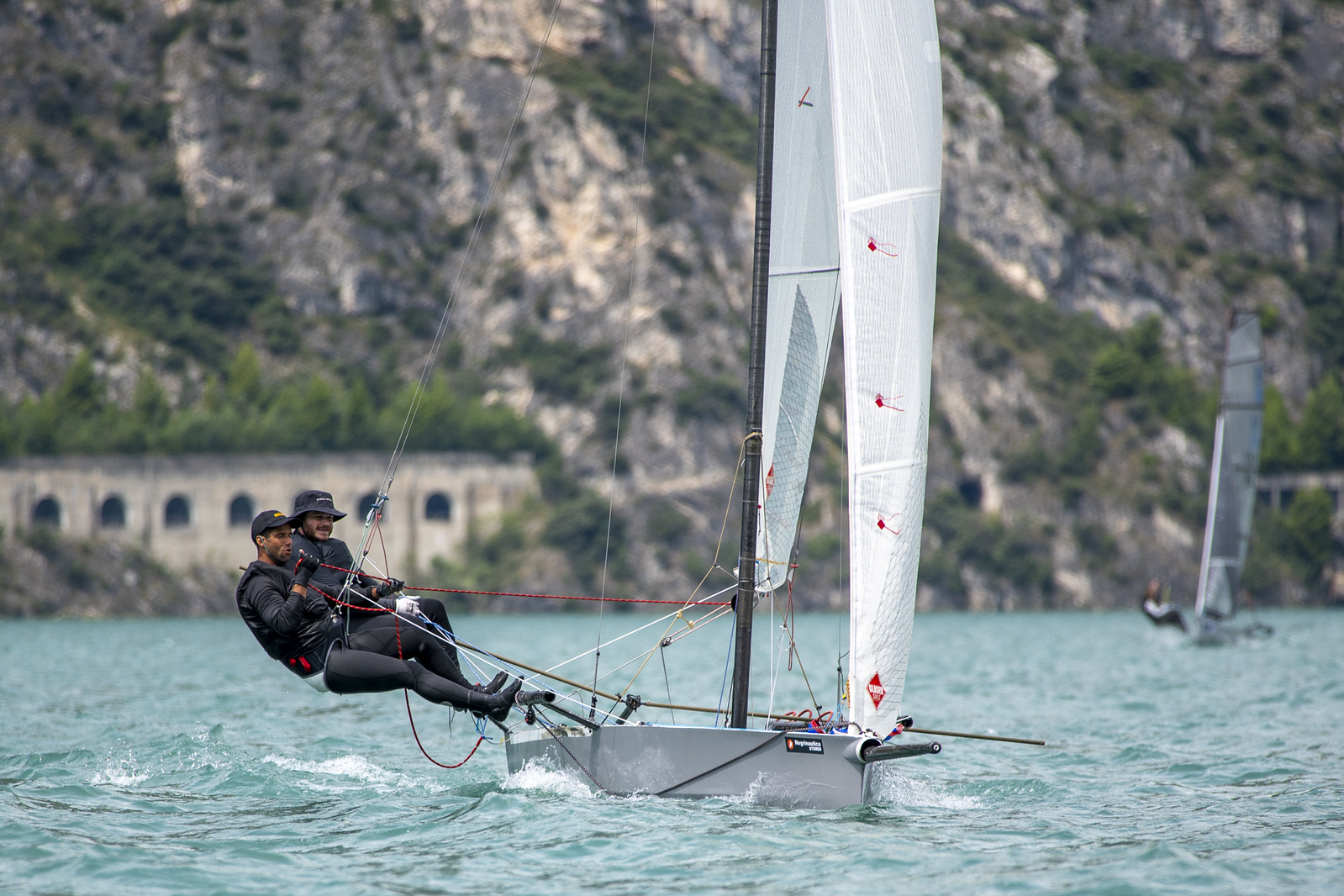 Photo Credit: Gleb Turchinovich Gleb.Turchinovich@gmail.com
Photo Credit: Gleb Turchinovich Gleb.Turchinovich@gmail.com
The following day was the “Practice Race’ which is a good warm up for several of the sailors as well as the RC. I-14s sail windward / leeward with triangle courses. The triangles are usually offset so as to require a high reach mark. This is what limits the size of the kites as the 25’ rig with 9’ bow sprit can carry an unlimited size kite. However, you can only measure in one kite. Kinda tough to change from an A2 runner to an A3 reaching kite between legs. The RC boat set up per usual. We asked how deep they were setting in and they answered 250 Meters, this is close to 800 feet of water. So once they are set, they aren’t moving. The Pin is a RIB with and small electric trolling motor which is set to maintain station via GPS coordinates. They now use ‘Mark Bots” for weather, reach and leeward marks which allows the RC to set a more normal course vs. previously having several marks using fixed mark mooring lines. The RC did set nice square lines with a large enough line to accommodate 70 boats. With that large of a line it is common for many, if not most, competitors to use electronics to ping the boat and pin, thus the midline sag of the past has been largely eliminated. The race goal is 90 min. for the winning boats which is usually an 18-20 mile race with one race per day.
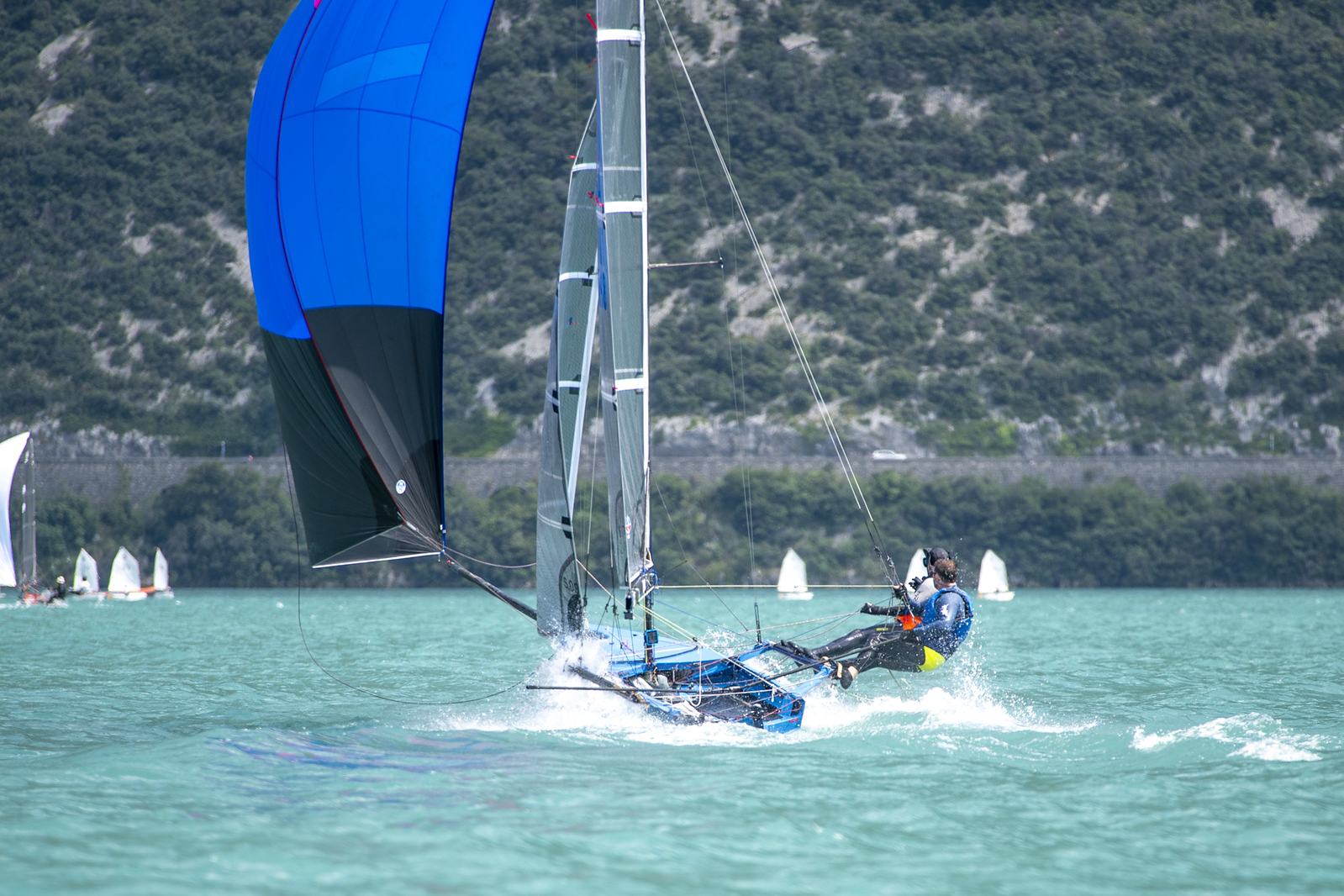 Photo Credit: Gleb Turchinovich Gleb.Turchinovich@gmail.com
Photo Credit: Gleb Turchinovich Gleb.Turchinovich@gmail.com
The North Lake Garda course is unfortunately a very one sided track as the southerly Ora breeze comes in predictably every day around 1200-1300. It gradually builds to 15-20 with occasional 20+ puffs. The breeze is significantly stronger along the right hand side of the course along the steep walls of the lake. Most places you can almost sail up and touch the wall prior to running out of water. As you sail here more you learn how favored it is and learn to get to the right hand side ASAP and short tack only a few hundred meters out into the lake prior to getting back to the wall. More pressure as well as a knock leading into the wall with some lift coming back out. The first few races as we sailed towards the middle of the lake we started sailing into a nice left handed shift, sailed into it a ways, tacked back on a nice lift only to see the boats that we sailed away from on the right gain 100m without the shift, but more pressure along the wall. This made for an almost obligatory Gybe set after the weather clearing mark on the first windward/leeward lap. Sprint back to the wall and get more pressure to get you down the course until you are going to gybe out to get to the leeward mark. Same situation on lap two, get to the wall and short tack until you can lay the weather mark again. There was often a knock as you came out into mid lake, so you learned to slightly overstand so you could maintain pace getting across to the weather mark again. Going down the left had side of the course to get to the reach mark was a little more tricky as there was usually some left breeze as previously noted, but this was usually lighter and puffy. Sometimes you would get a good left hand puff which would take you down below the reach mark, other times it was light and you had to reach up or Gybe out. Makes you learn to shift gears quickly and learn to reach with the kite up which seems to be a lost art with all the windward / leeward racing done these days. On occasions you can’t lay the reach mark and have to drop and two sail to the mark, reset and gybe or gybe set to the leeward mark. Lots of boat handling needed. The difficulty with this race track being so one sided, was if you didn’t get off the line or maintain a really good lane you are screwed as there are very few passing lanes. You can sail through some of the bottom of the fleet, but when you get to mid fleet or above those boats aren’t making the mistakes and everyone has good boat speed. The start became more challenging as many of the fleet started trying port tack starts and eliminate one tack. Talk about ‘danger zone’ in a 70 boat fleet. There were several repeat offenders with port tack fouls, the difficulty for the right of way starboard tackers was the port taker can foul you, do a single turn and still be way better off than fighting for a spot on starboard tack. Several boats were in the protest room repeatedly and got away with multiple fouls by “doing a turn”
 Photo Credit: Gleb Turchinovich Gleb.Turchinovich@gmail.com
Photo Credit: Gleb Turchinovich Gleb.Turchinovich@gmail.com
After one of these incidents occurring to us and having the protest disallowed because they “did their turn” We decided to go the pin end and make several of the port tackers duck us which allowed us to get and maintain a better lane. With this technique and “winning the pin” the last two days of racing we had our best results with a 14 and 21 in the last two races. Our boat handling was very good throughout the week, only one capsize due to a slip during a gybe. Or difficulty is not sailing against other good/fast boat consistently. We found we were sailing too fast uphill and needed to slow the pace down to 9.3-9.7 uphill to improve our point and maintain better lanes. Our downwind speed and depth continued to be good.
I had hoped for a top 20 finish, we ended up 26th out of 70 boats. We finished as the top US boat and 2nd North American boat. A bit disappointed in our early week, poorer results, but we did learn a lot and improved throughout the week.
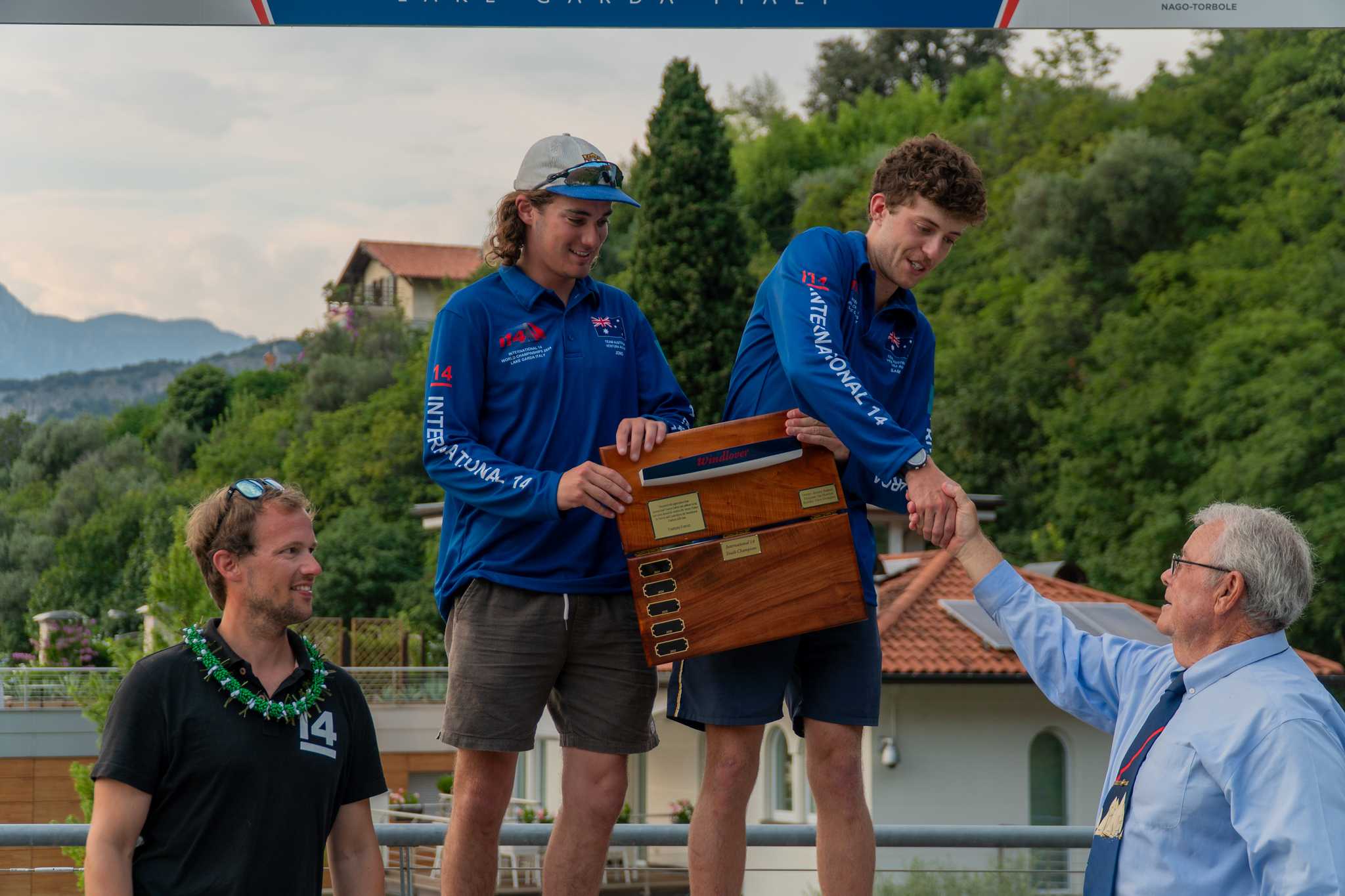 Photo Credit: Gleb Turchinovich Gleb.Turchinovich@gmail.com
Photo Credit: Gleb Turchinovich Gleb.Turchinovich@gmail.com
The next Worlds will be in Kingston, Ont. CAN in 2026 on the same waters as the 1976 Montreal Olympics were sailed. It is a beautiful area to sail as we were there for North Americans last summer. The following Worlds with be either at Black Rock in Melbourne AUS, or in Adelaide, in South AUS Dec/Jan 2028. There was some discussion about the 2029 worlds being back in the US and several discussions were had re: a possible San Diego Event as the worlds have previously been at St. Francis, Richmond x2, ABYC x2.
Respectfully,
Brad Ruetenik, DPM
Brad Ruetenik, DPM
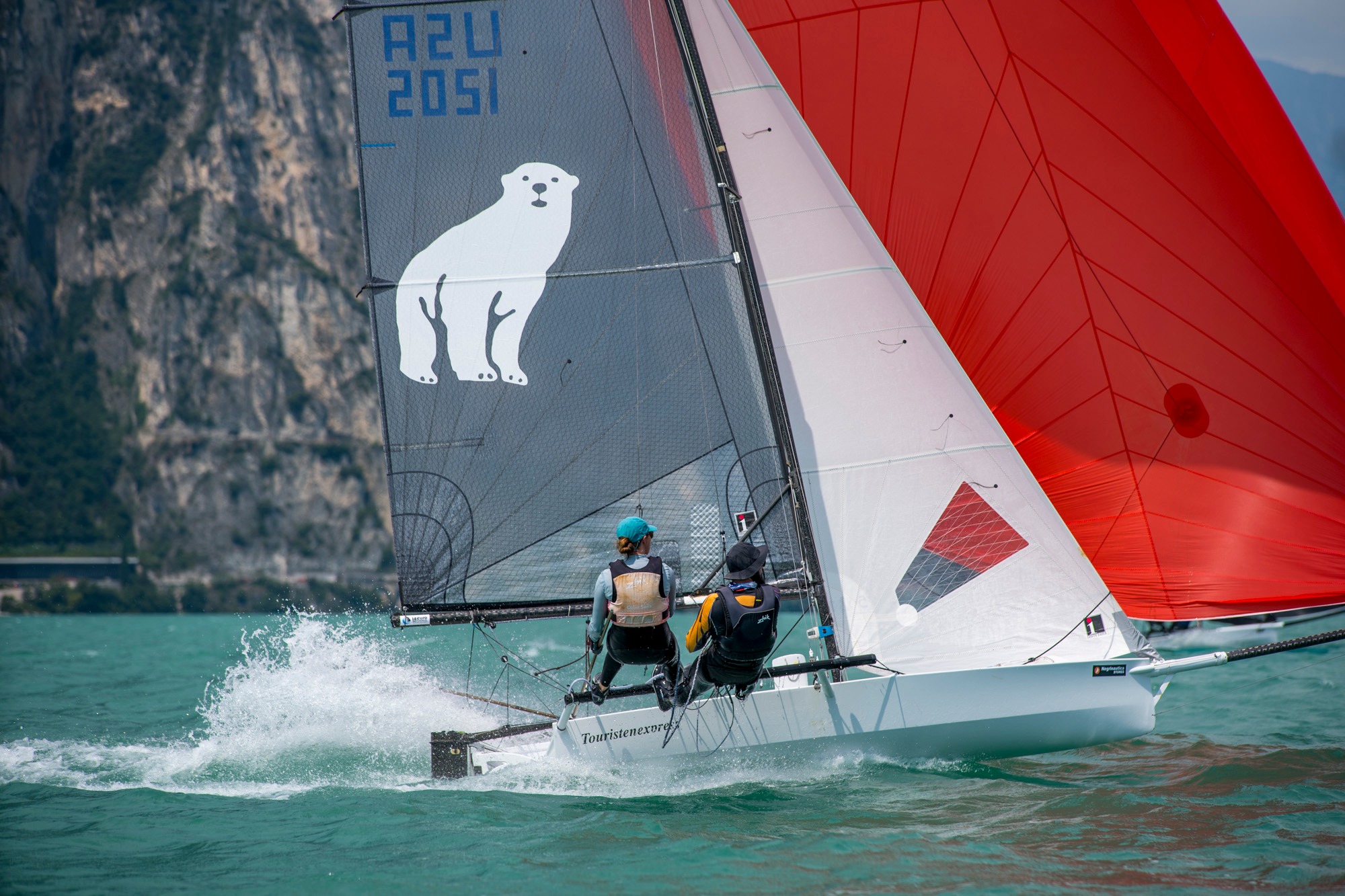 Photo Credit: Gleb Turchinovich Gleb.Turchinovich@gmail.com
Photo Credit: Gleb Turchinovich Gleb.Turchinovich@gmail.com
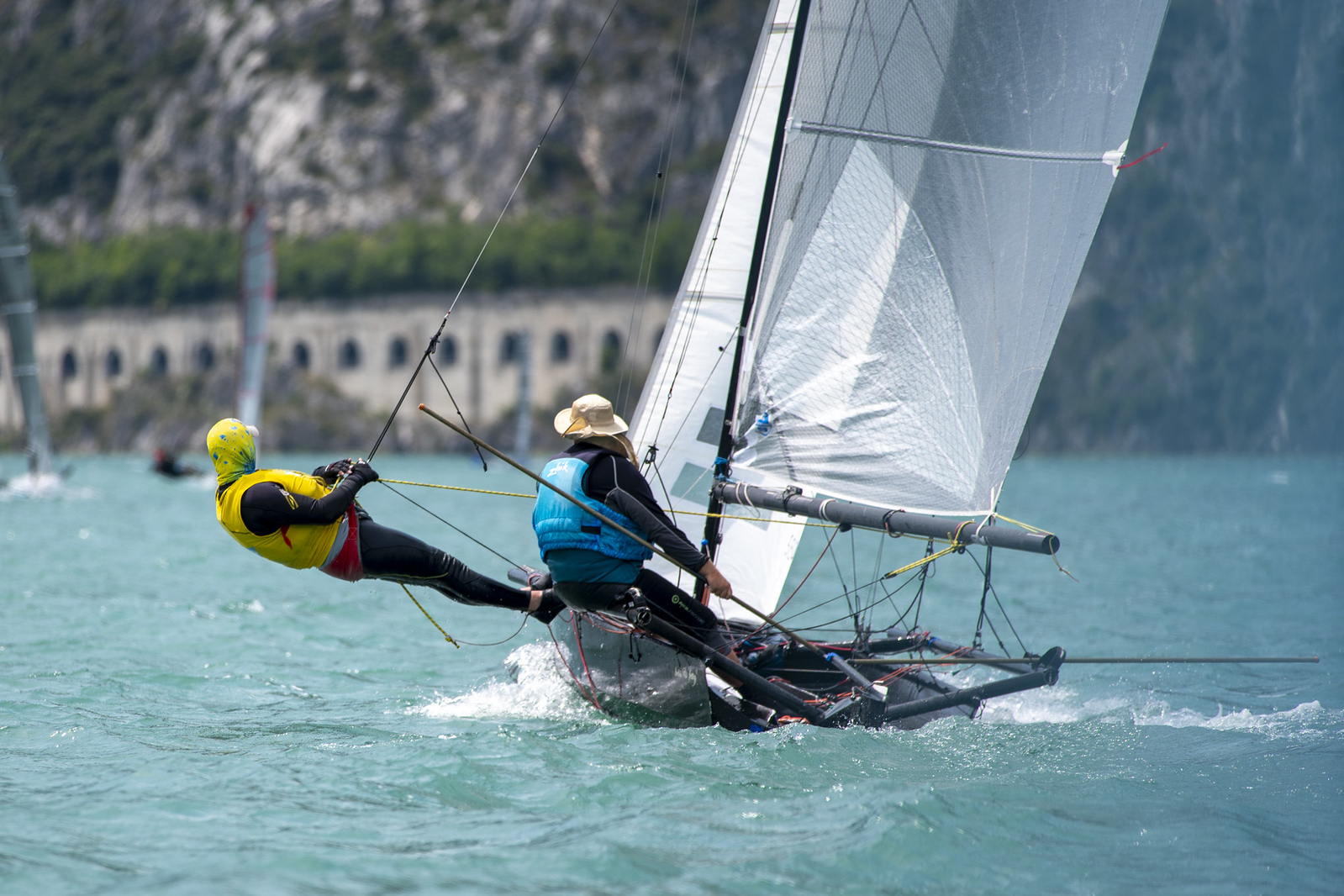 Photo Credit: Gleb Turchinovich Gleb.Turchinovich@gmail.com
Photo Credit: Gleb Turchinovich Gleb.Turchinovich@gmail.com
